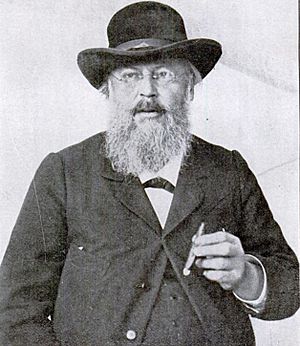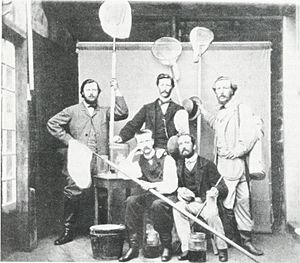Anton Dohrn facts for kids
Quick facts for kids
Felix Anton Dohrn
FRS, FRSE
|
|
|---|---|
 |
|
| Born | 29 December 1840 Stettin (Szczecin), Pomerania, Prussia
|
| Died | 26 September 1909 (aged 68) |
| Nationality | German |
| Education | University of Breslau |
| Known for | Principle of succession of functions, Der Ursprung der Wirbelthiere und das Princip des Functionswechsels: Genealogische Skizzen |
| Spouse(s) | Maria Baranowska |
| Children | 4 sons |
| Parent(s) |
|
| Relatives | Heinrich Wolfgang Ludwig Dohrn, brother |
| Scientific career | |
| Fields | Biology |
| Institutions | University of Jena, Stazione Zoologica, Naples |
| Thesis | On the Anatomy of Hemiptera |
| Doctoral advisor | Eduard Grube |
| Influences | St. George Mivart, Ernst Haeckel |
Felix Anton Dohrn (born December 29, 1840 – died September 26, 1909) was an important German biologist. He was a strong supporter of Charles Darwin's ideas about evolution. Anton Dohrn is most famous for starting the very first research center for studying animals, especially sea creatures. This center, called the Stazione Zoologica, is in Naples, Italy. He also studied how different body parts in animals can change their purpose over time.
Contents
Anton Dohrn's Early Life
Anton Dohrn was born in Stettin (Szczecin), which was part of Prussia at the time. His family was quite rich. His grandfather had earned a lot of money by trading in wine and sugar. This wealth meant Anton's father, Carl August Dohrn, could spend his time on hobbies like traveling, music, and studying insects.
Anton was the youngest son. He studied zoology (the study of animals) and medicine at several German universities. His brother, Heinrich Wolfgang Ludwig Dohrn, was also a zoologist.
In 1874, Anton Dohrn married Maria Baranowska. She was 16 years old and from Poland. They met in Messina, Italy. They had four sons: Boguslaw, Wolfgang, Harald, and Reinhard. Maria was very good with languages and became a successful translator.
Discovering Darwin's Ideas

Anton Dohrn's ideas about biology changed a lot in 1862. He was studying at Jena when Ernst Haeckel, another scientist, introduced him to Charles Darwin's work. Darwin's theories explained how living things change and develop over long periods. Dohrn quickly became a strong believer in Darwin's theory of evolution by natural selection.
At that time, studying how embryos (unborn or unhatched animals) develop was very important for understanding evolution. Scientists like Haeckel believed that an animal's development from an embryo showed the major stages of its species' evolutionary past. Dohrn decided to focus on this area, becoming a "Darwinian morphologist." This meant he studied the forms and structures of living things to understand their evolution.
Dohrn finished his main university studies in 1865. He then worked at several places by the sea to study marine life. He visited Heligoland with Haeckel in 1865. He also worked in Scotland and then moved to Messina, Italy, in 1868. There, he worked with his friend Nicholas Miklouho-Maclay to study the sea creatures in the Straits of Messina.
A New Idea: How Functions Change
One of Anton Dohrn's most important ideas was called the "principle of succession of functions." This idea explained how one body part could change its purpose over time and become the basis for a completely different organ. For example, he suggested that gills in fish, which are used for breathing underwater, could have changed over time to become other organs in animals with backbones, like jaws.
Creating "Zoological Stations"
While in Messina, Dohrn and his friend Miklouho-Maclay had a big idea. They wanted to create a network of research stations all over the world. These stations would be like "railway stations" for scientists. Scientists could stop at a station, collect samples, make observations, and do experiments. Then they could move on to the next station.
Dohrn realized how helpful it would be for scientists to arrive at a place and find a laboratory already set up. He tried renting rooms for a "Zoological Station" in Messina. But he soon understood that studying sea life properly needed a permanent building with trained staff and a good library.
Building the Stazione Zoologica
In 1870, Dohrn decided that Naples, Italy, would be a much better place for his research station. The Gulf of Naples had a huge variety of sea creatures. Also, Naples was a big city with a university and many international visitors. This made it a great spot for an important international research center.
Dohrn got another idea after visiting an aquarium in Berlin. He thought that if he charged people to visit an aquarium at his station, the money could help pay for a permanent assistant. Naples was a large, popular city with many tourists. This meant lots of people might visit the aquarium.
Dohrn managed to convince the city leaders of Naples. They agreed to give him a piece of land by the sea, in a beautiful park called the Villa Comunale. The only condition was that he had to build the Stazione Zoologica himself, using his own money.
He opened the station for visiting scientists in September 1873. The aquarium opened to the public in January 1874. In 1875, Dohrn published a book explaining his "change of function" theory for how animals with backbones evolved.
The "Bench" System
To make sure the Stazione Zoologica was important worldwide and could do research freely, Dohrn came up with a clever way to get money. He created the "Bench system."
Here's how it worked: Universities, governments, science groups, or even rich individuals could pay a yearly fee. In return, they could send one scientist to the Stazione for a year. That scientist would find everything they needed: a lab space, animals to study, chemicals, an amazing library, and expert staff. Dohrn even gave his own library to the station and got books donated from others. The best part was that scientists were completely free to work on their own ideas and projects.
This system was very successful. By the time Anton Dohrn died in 1909, more than 2,200 scientists from all over Europe and the United States had worked at the Naples station. Over 50 "benches" were rented out each year. The Stazione Zoologica helped create the idea of international scientific teamwork, where scientists share ideas and discoveries quickly and freely.
Anton Dohrn's Lasting Impact
Anton Dohrn's greatest achievements are the success of the Stazione Zoologica and his new way of thinking about how to fund and organize scientific research. His model was copied many times around the world.
- In 1878, Johns Hopkins University started the Chesapeake Zoological Laboratory in the US.
- In 1888, the Marine Biological Laboratory was founded at Woods Hole, Massachusetts.
- In 1892, the first lab on the west coast, the Hopkins Marine Station, opened in California.
- In Britain, many marine laboratories started around this time, like the Scottish Association for Marine Science (1884) and the Marine Biological Association of the United Kingdom in Plymouth (1888).
Anton Dohrn's name is also remembered in a special place underwater. The Anton Dohrn Seamount is an undersea mountain in the Rockall Trough, northwest of the British Isles. This area is known for its amazing variety of sea life, especially the cold-water coral called Lophelia pertusa.
Even a ship was named after him! The Carnegie Institution's marine biology lab in Florida launched a vessel called the Anton Dohrn in 1911. It was used for ocean science work. This ship even served in the United States Navy for a short time during World War I.
See also
 In Spanish: Anton Dohrn para niños
In Spanish: Anton Dohrn para niños





